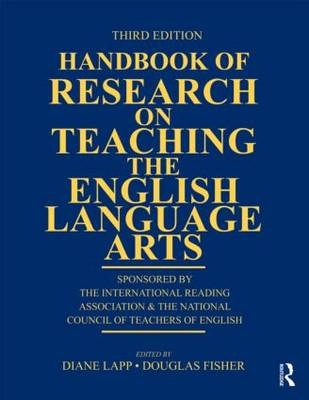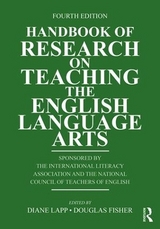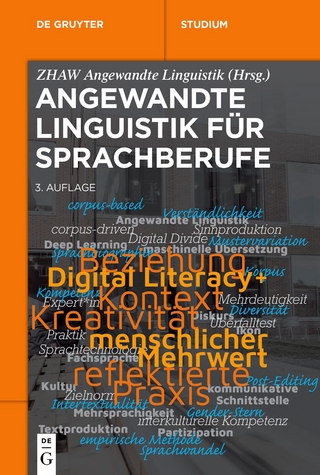
Handbook of Research on Teaching the English Language Arts
Routledge (Verlag)
978-0-415-87736-7 (ISBN)
- Titel erscheint in neuer Auflage
- Artikel merken
Now in its third edition, the Handbook of Research on Teaching the English Language Arts—sponsored by the International Reading Association and the National Council of Teachers of English—offers an integrated perspective on the teaching of the English language arts and a comprehensive overview of research in the field. Prominent scholars, researchers, and professional leaders
provide historical and theoretical perspectives about teaching the language arts
focus on bodies of research that influence decision making within the teaching of the language arts
explore the environments for language arts teaching
reflect on methods and materials for instruction
Reflecting important recent developments in the field, the Third Edition is restructured, updated, and includes many new contributors. More emphasis is given in this edition to the learner, multiple texts, learning, and sharing one’s knowledge. A Companion Website, new for this edition, provides PowerPoint® slides highlighting the main points of each chapter.
Diane Lapp is Professor of Reading and Language in the Department of Teacher Education at San Diego State University. Douglas Fisher is Professor of Language and Literacy Education in the Department of Teacher Education at San Diego State University.
Section I: The Language Learner
Section Editors
Nancy Roser, Maria Franquiz, Allison Skerrett
Chapters
1. Valdez, Veronica. & Callahan, Rebecca.
Who is Learning Language(s) in Today’s Schools?
2. Cazden, Courtney.
As Learners Acquire Language
3. Escamilla, Kathy. & Hopewell, Susan.
When Learners Speak Two or More Languages
4. Ball, Arnetha., Skerrett, Allison.; & Martinez, Ramon.
Research on Diverse Students in Culturally and Linguistically Complex Language Arts Classrooms
5. Franquiz, Maria. & Pratt, Ellen.
Crossing Borders with Language: Teachers and the Transformative Potential of Professional Development Opportunities
Section II: Contexts for Language Learning
Section Editors
Donna E. Alvermann, Christine A. Mallozzi, Cheryl A. McLean
6. Morrow, Lesley Mandel & Dougherty, Susan
Early Literacy Development: Merging Perspectives That Influence Practice
7. Strickland, Dorothy & Townsend, Dianna
The Development of Literacy in the Elementary School
8. Many, Joyce E.; Ariail, Mary & Fox, Dana L.
Language Arts Learning in the Middle Grades
9. Bean, Thomas W. & Harper, Helen.
The Context of English Language Arts Learning: The High School Years
10. Morrell, Ernest.
Context Specific Literacy Instruction
11. Muth, Bill & Perry, Kristen.
Adult Literacy: A Review from Two Perspectives
12. Brock, Cynthia; Boyd, Fenice; & Pennington, Julie.
Variation in Language and the Use of Language Across Contexts: Implications for Literacy Teaching and Learning
13. Paratore, Jeanne R. & Yaden, Jr., David B.
Family Literacy on the Defensive: The Defunding of Even Start—Omen or Opportunity?
14. Vasudevan, Lalitha & Wissman, Kelly.
Out-of-School Literacy Contexts
15. Luke, Allan, Iyer, Radha; & Doherty, Catherine.
Literacy Education in the Context of Globalisation
Section III: History and Theoretical Perspectives
Section Editors
Lesley Mandel Morrow, Robert Rueda, Douglas Hartman
16. Hartman, Douglas K. & Monaghan, Jennifer.
Integrating the Elementary Language Arts: An Historical Perspective
17. Levin, Henry.
The Consideration of Costs in Improving Literacy
18. Guthrie, John T.; Taboada, Ana; & Wigfield, Allan.
Alignment of Cognitive Processes in Reading with Motivations for Reading
19. Enciso, Patricia.
Sociocultural Theory: Expanding the Aims and Practices of Language Arts Education
20. Jimenez, Robert T.; Rose, Brian C.; Cole, Mikel W.; & Flushman, Tanya R.
English Language Learners: Language and Relationships
21. Beach, Richard & Swiss, Thomas.
Literary Theories and Teaching of English Language Arts
22. Shanahan, Timothy.
Education Policy and the Language Arts
Section IV: The Many Faces of Texts
Section Editors
Peggy Albers, Vivian Vasquez, Jerome Harste
23. Beach, Richard, Hull, Glynda, and O’Brien, David.
Transforming English Language Arts in a Web 2.0 World
24. Levy, Rachel and Marsh, Jackie.
Literacy and ICT in the Early Years
25. Rowsell, Jennier and Pahl, Kate
The Material and the Situated: What Multimodality and New Literacy Studies Do For Literacy Research
26. Tate, Stacie.
Media Literacy
27. Wohlwend, Karen and Lewis, Cynthia.
Critical Literacy, Critical Engagement, and Digital Technology: Convergence and Embodiment in Global Spheres
28. Albers, Peggy, Vasquez, Vivian, and Harste, Jerome C.
Making Visual Analysis Critical
29. Siegel, Margie and Wells-Rowe, Debbie.
Webs of Significance: Semiotic Perspectives on Text
Section V: Teaching the English Language Arts
Section Editors
Karen Wood, Nancy Frey, Wen Ma
30. Hruby, George; Read, Sylvia & Landon-Hays, Melanie.
Tracing Instructional Tensions in the Teaching of the English Language Arts: A Primer
31. Tschannen-Moran, Megan & MacFarlane, Bronwyn.
I Know I Can!: Teacher Self-efficacy in the English Language Arts Classroom
32. Edmiston, Brian.
Teaching for Transformation: Drama and Language Arts Education
33. Ehri, Linnea.
Teaching Phonemic Awareness and Phonics in the Language Arts Classroom: A Developmental Approach
34. Rasinski, Timothy.
The Art and Science of Teaching Reading Fluency
35. Templeton, Shane.
Teaching Spelling in the English/Language Arts Classroom
36. Fisher, Peter; Blachowicz, Camille; & Watts-Taffe, Susan.
Vocabulary Instruction: Three Contemporary Issues
37. Fisher, Douglas, Lapp, Diane, & Frey, Nancy.
Comprehension: The Cooperation of Many Forces
38. Roser, Nancy; Martinez, Miriam; & Wood, Karen.
Recent Research on Students’ Literary Responses
39. Hansen, Jane & Kissel, Brian.
K-12 Students as Writers: Research and Practice
40. McLaughlin, Maureen & DeVoogd, Glen.
Critical Literacy as Comprehension: Understanding at Deeper Levels
41. Hobbs, Renee & RobbGrieco, Michael.
Passive Dupes, Code Breakers or Savvy Users: Theorizing Media Literacy Education in English Language Arts
42. Nelson, Nancy.
The Relevance of Rhetoric
43. Gebhard, Meg & Martin, J. R.
Grammar and Literacy Learning
Section VI: Assessment of English Language Arts Teaching and Learning
Section Editors
Jennifer D. Turner, Patricia Ruggiano Schmidt, Peter Afflerbach
44. Afflerbach, Peter & Clark, Summer.
Diversity and English Language Arts Assessment.
45. Coiro, Julie & Castek, Jill.
Assessment Frameworks for Teaching and Learning English Language Arts in a Digital Age
46. Schmidt, Patricia R. & Singh, Sunita.
Authentic Professional Development and Assessment for Language Arts Teachers Capacity for Change
47. Turner, Jennifer D. & Hoeltzel, Chrystine.
Assessing Every Child: Using Purposeful Language Arts Assessments in Diverse Classrooms
48. Klingner, Janette K.; Dunsmore, KaiLonnie; & Edwards, Patricia.
Issues in the Assessment of Culturally and Linguistically Diverse Students with Special Needs
49. Gunderson, Lee; Odo, Dennis Murphy & D’Silva, Reginald.
Assessing the English Language Learner (ELL)
Section VII: Methods of Research on Teaching the English Language Arts
Section Editors
David Bloome, Thandeka Chapman, Peter Freebody
50. Bloome, David; Chapman, Thandeka; & Freebody, Peter.
Complexity, Multiplicity, `Timeliness’, and Substantive Engagement: Methodologies for Researching the Teaching of the English Language Arts
51. Athanases, Steven Z.
Research as Praxis: Documenting the Dialectical Relationship Between Theory and Practice
52. Freebody, Peter.
Policy and Research in the English Language Arts: Massive, Inclusive, and Artful Design Choices
53. Moss, Gemma.
Ethnographic Research in Teaching and Learning the English Language Arts: Studying the Cultural Contexts of Teaching and Learning the English Language Arts
54. Carter, Stephanie.
Analyzing Text and Talk through Critical Discourse Analysis
55. Chapman, Thandeka K. & Kinloch, Valerie.
Emic Perspectives of Research
56. Calfee, Robert C. & Chamblis, Marilyn.
Research Methodologies for Large-Scale Instructional and Intervention Studies
57. McNaughton, Stuart.
Child Development Studies over Time
58. Smagorinsky, Peter.
Theory and Method in Research on Literacy Practices: Adaptations and Alignment in Research and Praxis
59. Liddicoat, Anthony T.
English in the Era of Globalisation: Implications for Research Methodologies for English Language Arts
60. Gutierrez, Kris D.; Bien, Andrea C.; & Selland, Mackenzie K.
Syncretic Approaches to Studying Movement and Hybridity in Literacy Practices
61. Willis, Arlette.
Critical Approaches to Research in English Language Arts
Contributors
| Erscheint lt. Verlag | 1.2.2011 |
|---|---|
| Zusatzinfo | 13 Line drawings, black and white; 5 Halftones, black and white; 5 Tables, black and white |
| Verlagsort | London |
| Sprache | englisch |
| Maße | 219 x 276 mm |
| Gewicht | 1052 g |
| Themenwelt | Schulbuch / Wörterbuch ► Wörterbuch / Fremdsprachen |
| Geisteswissenschaften ► Sprach- / Literaturwissenschaft ► Sprachwissenschaft | |
| Sozialwissenschaften ► Pädagogik | |
| ISBN-10 | 0-415-87736-9 / 0415877369 |
| ISBN-13 | 978-0-415-87736-7 / 9780415877367 |
| Zustand | Neuware |
| Haben Sie eine Frage zum Produkt? |
aus dem Bereich



